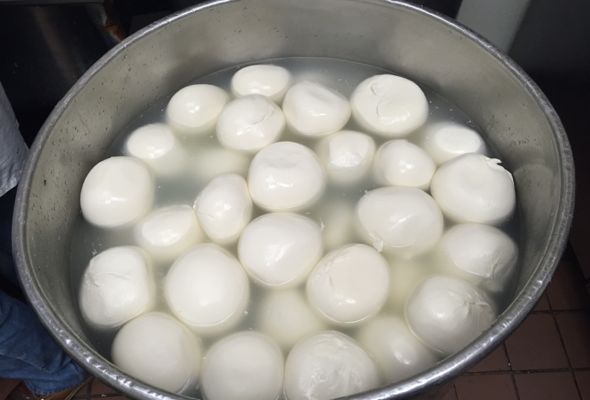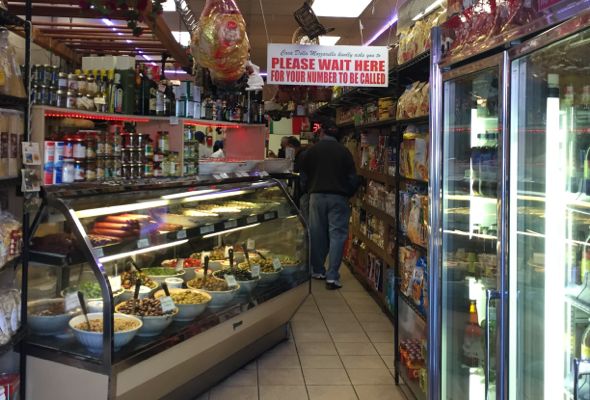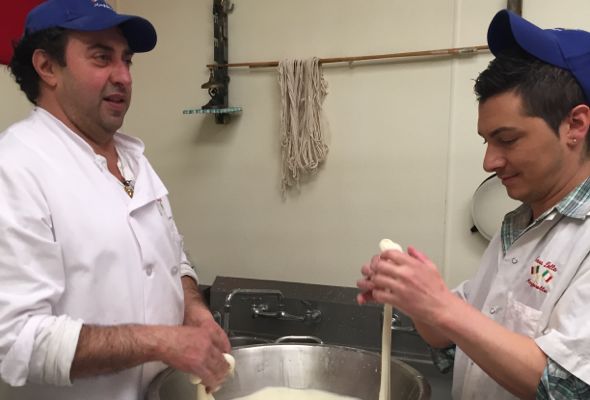A taste of home
The area around Arthur Avenue and 187 Street in the Bronx is packed with an Italian pastry store, a Mexican-American restaurant, a frozen yogurt parlor and a pizza shop. Wedged between them in the narrowest storefront is 93-year-old Casa Della Mozzarella, where customers line up for four hours on a holiday for the homemade mozzarella.
There are shelves of imported pastas, olive oils, tomatoes for making sauce and spices from Italy. Deli cases are stocked with a variety of olives, meats like dried salami and prosciutto and fragrant cheeses, the Italian appetizing necessities.
Owner Orazio Carciotto, 56, moved to New York 28 years ago with no English and a job history that included being a barber, selling lemons and working in an auto parts store, none of which he wanted to do in the states.
“I didn’t speak a word of English, only Italian. I needed a job, so my wife said the only place you can get a job is in little Italy in the Bronx,” said Carciotto, who immigrated from Sicily to live with his American wife. “I wanted to do something different and the only thing, maybe can I try to work in a deli.”
Carciotto visited Arthur Avenue, in Belmont, and found Casa Della Mozzarella; the deli’s original owner, Nicky Ceglia told him he needed someone to make mozzarella.
“I had no idea how to make mozzarella when I came here,” said Carciotto.
His wife’s family was less than supportive of his job, he says, and he longed to be back in Sicily with his family and friends. Then his wife got pregnant, and his attitude changed.
“One morning I woke up and said ‘I love America and I love making mozzarella,'” said Carciotto. He made a commitment to his new life. After six years of working for Ceglia, Carciotto purchased the business in 1993.
“The business was good at the time, but the business was very old, so I decided to remodel everything and after that things started to pick up because people could see me making mozzarella and I could add more things,” said Carciotto.
In 1998 he rearranged the store’s layout so that customers could watch him making mozzarella behind the cash register, and he added imported grocery items from Italy like pastas, sauces, spices and olive oils, to give the store a more authentic feel.
Carciotto makes mozzarella from 7 a.m. until 5 p.m. daily. He purchases mozzarella curd from Polly-O, cuts it up and places it in warm water until it reaches room temperature. Then he drains the water, adds salt and places the curd in boiling water, stirring until it acquires a doughy consistency. Next, he breaks it into pieces and molds them into balls, which are submerged in warm water followed by cold water, to form a firm exterior. The water temperature must change gradually, in order not to shock the cheese; the finished mozzarella balls stay in cold the water until they are purchased.
In about 15 minutes, Carciotto can make 20 pounds of mozzarella, approximately 3,000 pounds per week — three times the store’s pre-remodel output. The mozzarella’s price depends on the curd’s price. Currently he charges about $8.50 per pound.
With increased production, Carciotto needed an extra set of hands to meet the demand, which now included wholesalers and local restaurants like Antonio’s Trattoria in Belmont, Grace’s Market in New York City and Decicco Marketplace in Scarsdale.
At first Carciotto hired several fellow Italian immigrants who already knew how to make mozzarella, but they didn’t want to adapt to his style.
“I need to teach them from scratch. If you want to work with me, it’s my way or no way,” said Carciotto.
About 10 years ago, Carciotto found the right apprentice, Alessandro Fava, 30, who moved to the states from Italy in 2000 and had previously worked in a deli owned by his family in Stratford, Conn.
Like his boss, Fava had other plans for life in America.
“I didn’t choose it,” said Fava about his deli work. “I always wanted to be a veterinarian, but then with moving here, everything goes all over the place.”
Fava met Carciotto through his father, whose first job in America was in a butcher shop on Arthur Avenue, but he was already familiar with the shop from visits with his mother.
The early years on the job were difficult.
“It was horrifying, especially when you learn something you never did,” said Fava. “It took me a couple of years to learn how to make it and a lot of pressure because he is number one in New York City.”
Arthur Avenue never represented the same authentic taste of Italy for Fava as it once did for Carciotto, as the neighborhood is now more diverse. “Before a lot of Italians lived here, but it doesn’t even look like the business changed. Seventy-five percent of my customers are Italians,” said Carciotto. “Business-wise it didn’t change, but residential-wise it changed.”
With the construction of the Bronx zoo and botanical gardens in 1898, Italians immigrated directly to the neighborhood in hopes of employment, and the Italian community grew from there, according to the Belmont BID. But as that community discovered other areas of the city, the local population shifted. As of 2013, 64.3 percent of Belmont’s population was Latino, with 75.6 percent of the foreign-born population from Latin America, according to the U.S. Census Bureau. Italians now make up only 3.6 percent of the neighborhood’s population.
“It’s a shame. This was a very heavy Italian populated neighborhood,” said Pete Fusco, a Casa Della Mozzarella deli man for the past 10 years and resident of the Bronx for 30 years. “All the Italian people either passed away or they moved. They still come back to get the food, but not live here.”
Now Casa Della Mozzarella’s customers come from places like Long Island, New Jersey and Westchester County. This is a trend in the neighborhood, as 85 percent of the customers who shop on Arthur Avenue come from more than five miles away, according to Alyssa Tucker, the assistant director of the Belmont BID, who says that the average income of Belmont residents is below poverty levels.
“If we had to rely on the neighborhood people we would close,” said Fusco.
Despite the changing neighborhood, the business continues to grow.
“It gets busier and busier,” said Fusco. “We have people that come here and go ‘I brought my friend from Connecticut’ and then they become a customer.”
The shop averages about 150 customers a day, according to Felicia Russo, who has run the cash register for the last eight years.
“I love my customers. I really do. I worry about them. Over the years, I’ve built relationships with people,” said Russo, who has lived on Arthur Avenue her entire life.
The Belmont BID hopes to preserve the camaraderie among the Italian businesses that are left; Carciotto learned how to make burrata from his friend who works at Joe’s Deli down the block.
“I’m going to try and keep my business here for a long time because you need the relationships with customers,” said Carciotto, who hopes someday to turn the shop over to his 25-year-old son. “You need to try to keep people happy and don’t change things.”




Your Comments